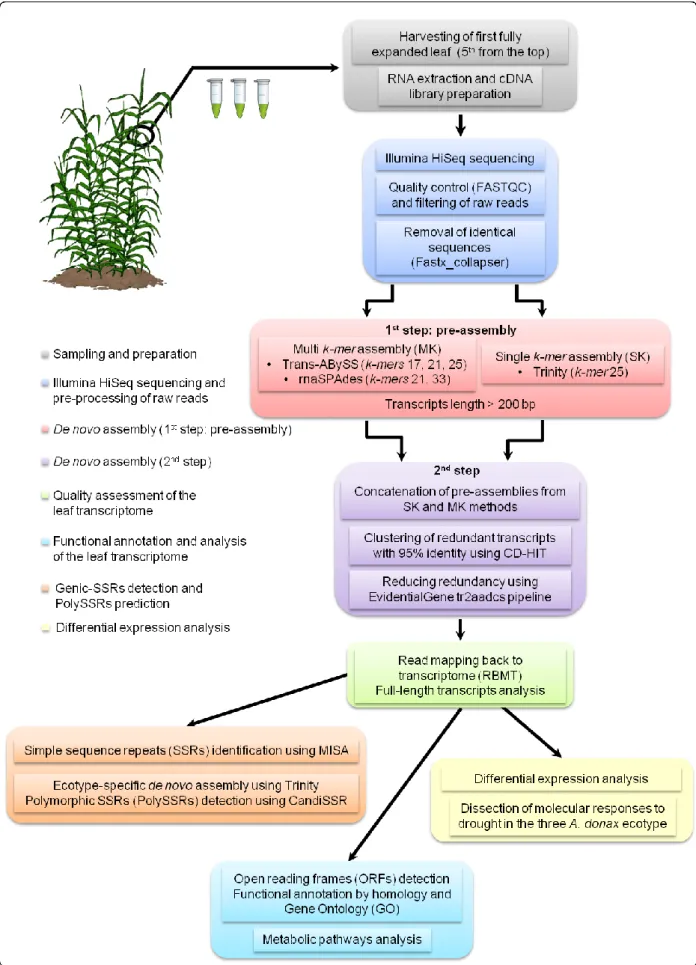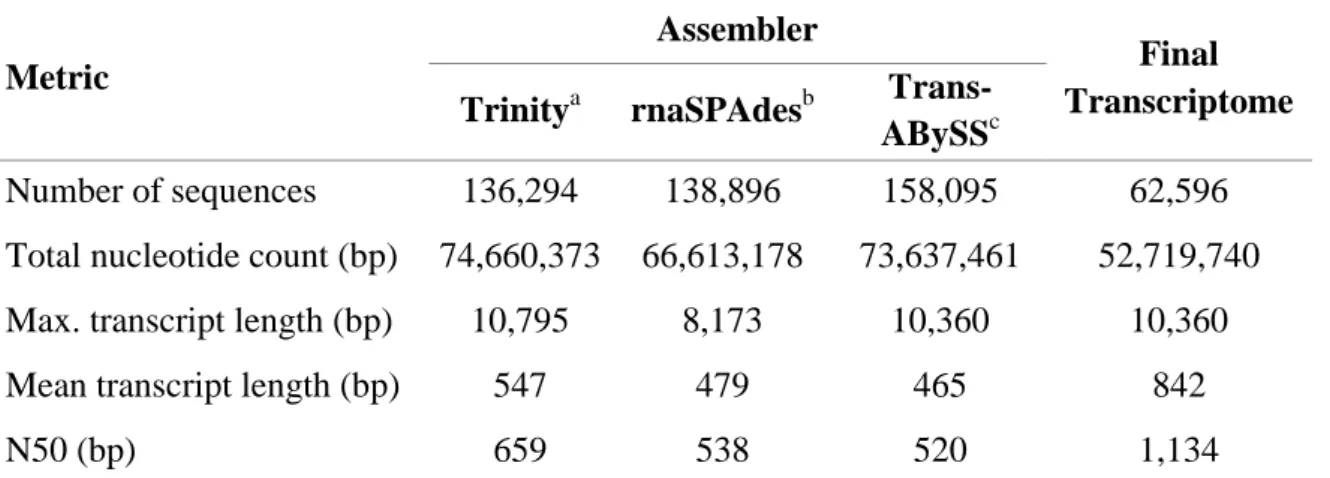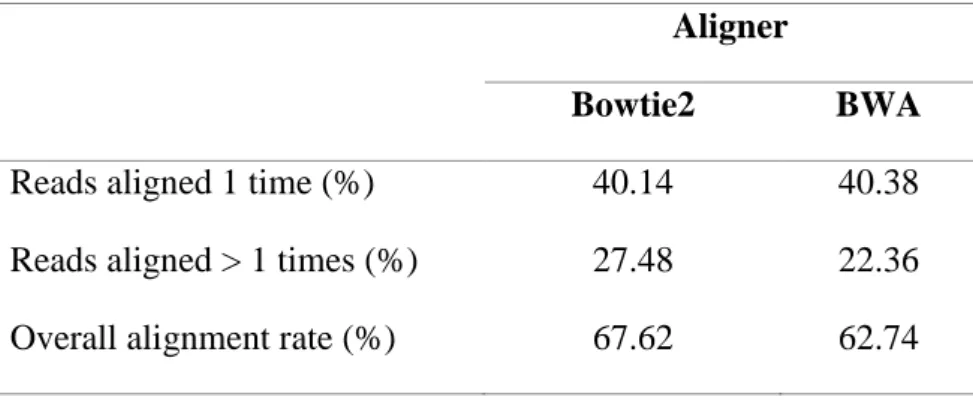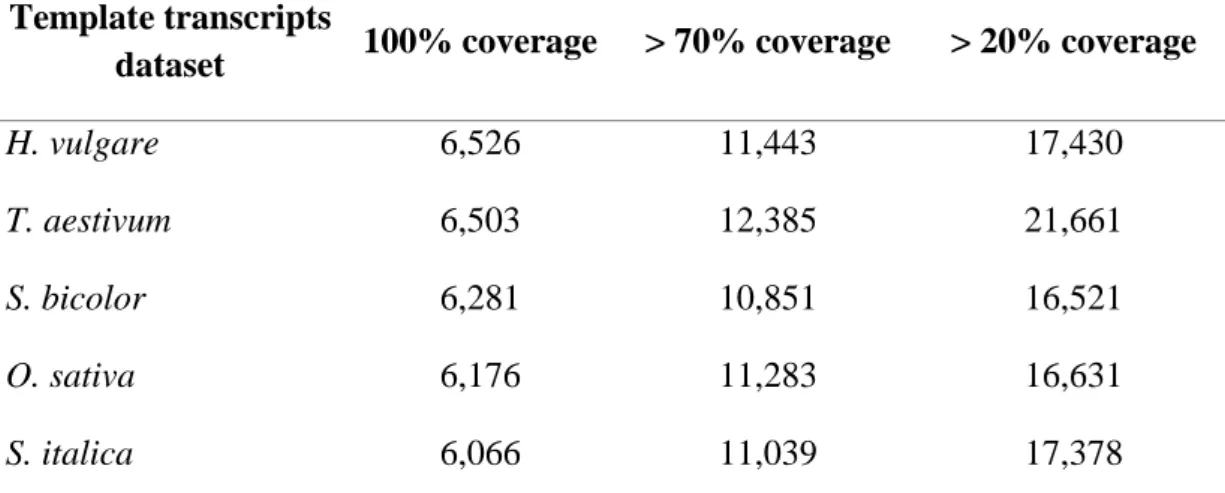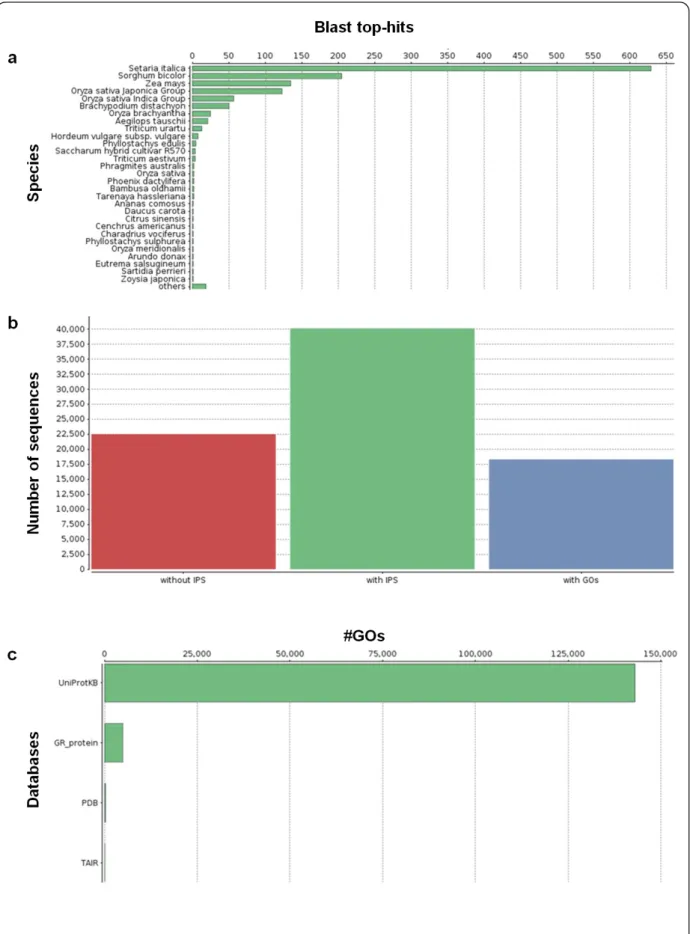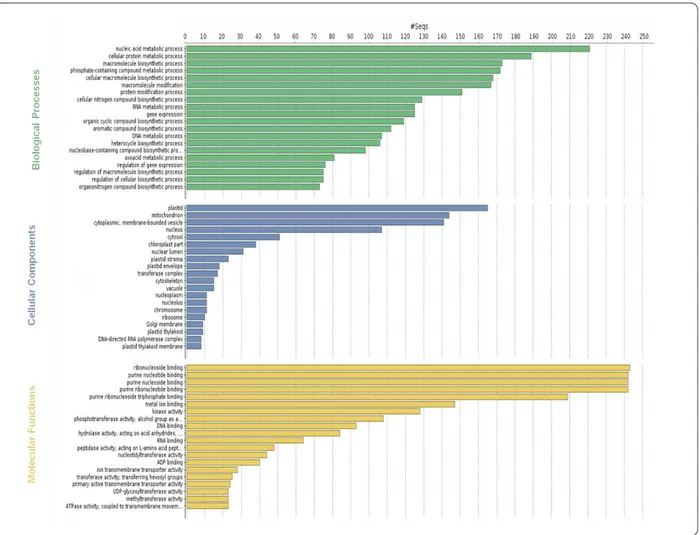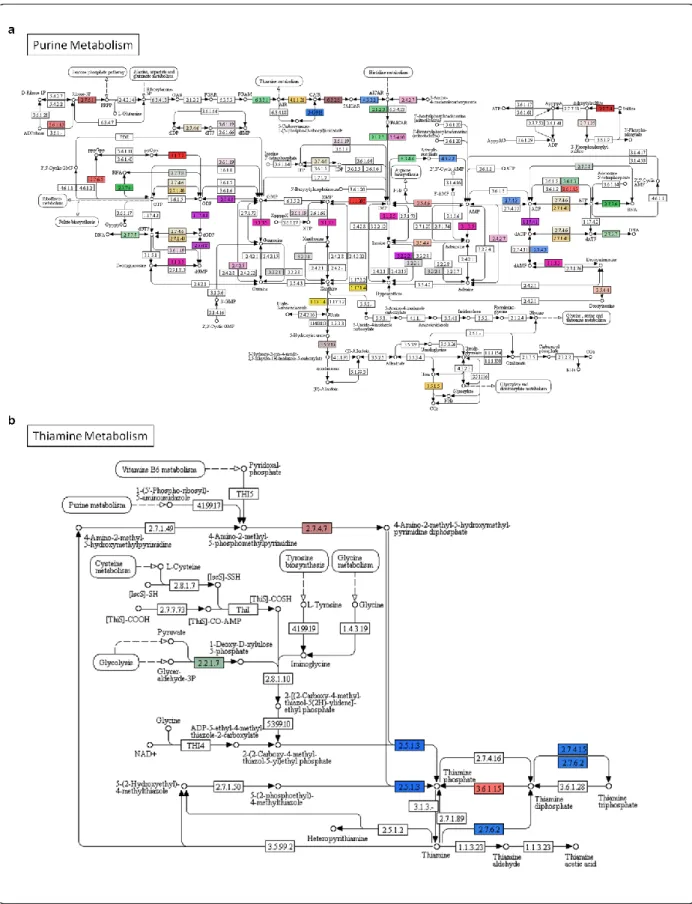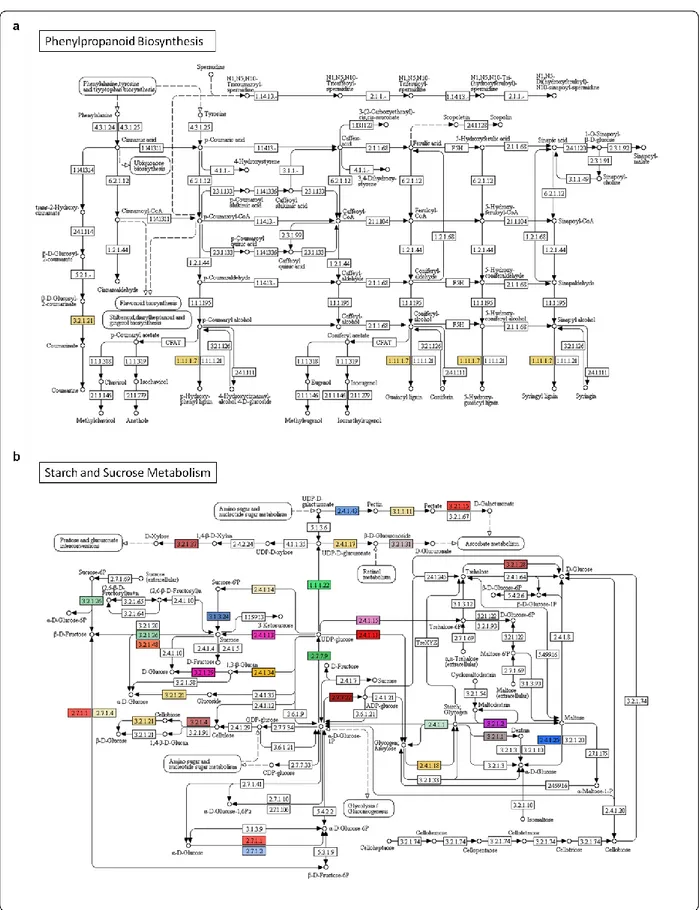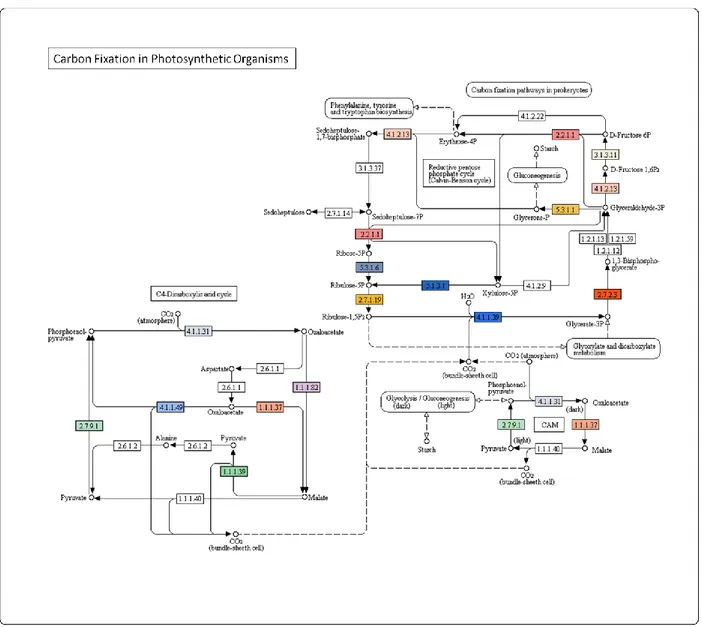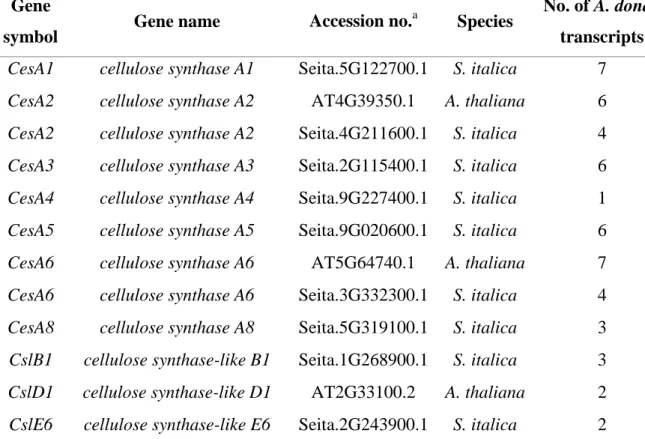UNIVERSITY OF TUSCIA
Department for Innovation in Biological, Agro-food and Forest systems –
DIBAF
1
Ph.D. in Science, Technology and Biotechnology for Sustainability
2(Biological Systems/Bioindustries)
3XXIX Cycle
4 5De novo assembly of giant reed (Arundo donax L.) leaf transcriptome using
RNA-Seq provides insight into drought response, gene discovery and
genetic marker identification
Ph.D. Candidate
6Chiara Evangelistella
7(AGR/05)
8 9 10Tutor
Coordinator
11Prof. Antoine Harfouche
Prof. Mauro Moresi
12 13 14 15 Academic year 16 2016-2017 17 18
ii
This thesis was submitted to the Department for Innovation in Biological, Agrofood and 19
Forest systems as a doctoral dissertation in partial fulfillment of the requirements for the 20
degree of PhD in Science, Technology and Biotechnology for Sustainability (Biological 21
Systems/Bioindustries) at the University of Tuscia, Viterbo, Italy. 22
23
Head of Department: Prof. Dr. Giuseppe Scarascia Mugnozza 24
Coordinator of the PhD program: Prof. Mauro Moresi 25
26
Members of the examination committee: 27
Chairman: Prof. Dr. Giuseppe Scarascia Mugnozza 28
Examiner: Prof. Dr. Alessio Valentini 29
Examiner: Prof. Dr. Maurizio Sabatti 30
Thesis Supervisor: Prof. Dr. Antoine Harfouche 31
iii 33 34 35 36 37 38 39 40 41 42 43 44 © 2016 Chiara Evangelistella 45
All rights reserved 46 47 48 49 50 51 52 53 54 55 56 57 58 59 60
iv
CIRCULATION RESTRICTION 61
62 63
To Whom It May Concern, 64
I would like to request that a circulation restriction be placed on my dissertation “De novo 65
assembly of giant reed (Arundo donax L.) leaf transcriptome using RNA-Seq provides insight 66
into drought response, gene discovery and genetic marker identification” for a period of 1 67
year, because an article on this subject has been submitted for publication and others are being 68
written. I have discussed this with my professor and we both agree. I understand that one 69
electronic copy of the dissertation will be available only at the Library of the University of 70 Tuscia. 71 72 Sincerely, 73 Chiara Evangelistella 74 75 Antoine Harfouche 76 77 78 79 80 81 82
v
TABLE OF CONTENT
EXTENDED ABSTRACT
3
AIM OF THE WORK
5
1.
STATE OF THE ART
6
1.1 Origin, diffusion and reproduction of A. donax 6
83
1.2 A. donax as a biomass crop in different environmental and climatic conditions 7 84
1.3 A. donax as a biomass feedstock for bioenergy and biofuel production 9 85
1.4 A glimpse into Next-Generation Sequencing (NGS) technologies 11 86
1.5 Uncovering transcriptomes in non-model plant species using RNA-Sequencing 12 87
2.
INTRODUCTION
14
3.
MATERIAL AND METHODS
17
3.1 Plant material and experimental design 17
88
3.2 RNA isolation, cDNA library construction and Illumina sequencing 18 89
3.3 Quality control and filtering of read dataset 19
90
3.4 De novo assembly strategy for leaf transcriptome reconstruction 19 91
3.5 Reads Mapping Back to Transcriptome (RMBT) 20
92
3.6 Full-length transcript analysis 21
93
3.7 Functional annotation of the leaf transcriptome catalogue 21 94
3.8 Identification of genic-SSRs and development of polymorphic SSR markers 23 95
3.9 Validation of PolySSR markers by PCR and Sanger sequencing 24 96
3.10 Identification of differentially expressed transcripts in three A. donax ecotypes under 97
drought stress 25
98
3.10.1 Alignment and abundance estimation of RNA-Seq reads 25 99
3.10.2 Pairwise statistical analysis to reveal differentially expressed transcripts 25 100
3.10.3 Functional characterization and analysis of differentially expressed transcripts 26 101
4.
RESULTS
26
4.1 Sequencing of the A. donax leaf transcriptome 26
vi
4.2 Leaf transcriptome de novo assembly of A. donax 29
103
4.3 Quality assessment of the leaf transcriptome assembly 31 104
4.4 Functional annotation of the leaf transcriptome by homology 33 105
4.5 Functional annotation of the leaf transcriptome by GO 34 106
4.6 Biological pathway analyses in A. donax 37
107
4.7 Interspecies comparisons of A. donax pathways 43
108
4.8 Genic-SSR marker mining and SSR polymorphism detection 46 109
4.9 Gene functions of the unitranscript sequences containing PolySSRs 50 110
4.10 Experimental validation of PolySSR markers 51
111
4.11 Differential gene expression analysis in three A. donax ecotypes in response to drought 51 112
4.12 Dissection of the different molecular responses to drought and selection of candidate genes 113
in the three A. donax ecotypes 66
114
5.
DISCUSSION
71
6.
CONCLUSION
83
7.
ACKNOWLEDGEMENTS
83
8.
REFERENCES
84
9.
LIST OF PAPERS
102
10.
LIST OF TABLES
103
11.
LIST OF FIGURES
104
1
SHORT ABSTRACT
Arundo donax has attracted renewed interest as a potential candidate bioenergy crop for 115
use in biomass-to-liquid fuel-conversion processes and biorefineries, due to its high 116
productivity, adaptability to marginal lands (e.g. drought-prone environments), and suitability 117
for biofuel and biomaterial production. However, currently genomic resources publicly 118
available for supporting A. donax improvement and information about its molecular response 119
to drought in field are still limited. 120
RNA-Seq was used to de novo assemble and characterize the A. donax leaf transcriptome. 121
The sequencing generated 1,249 million clean reads that were assembled into 62,596 unique 122
sequences (unitranscripts). TransDecoder and Trinotate softwares were used to obtain 123
putative coding sequences and to annotate them by mapping to UniProtKB/Swiss-Prot and 124
UniRef90 databases, searching for known transcripts, proteins, protein domains and signal 125
peptides. Furthermore, the unitranscripts were annotated by mapping them to the NCBI non-126
redundant, GO and KEGG databases using Blast2GO. The transcriptome was also 127
characterized by customized BLAST searches to investigate homologous transcripts of genes 128
coding for stress-associated proteins (SAPs), and key genes involved in important metabolic 129
pathways, such as lignin, cellulose, purine and thiamine biosynthesis, stomatal development 130
and carbon fixation. Additionally, 8,364 SSR markers were identified, representing the first 131
genetic marker catalog of A. donax. 53 SSRs were then predicted to be polymorphic between 132
ecotype-specific assemblies, suggesting genetic variability among the A. donax ecotypes 133
(EcoA, EcoB and EcoC). Differentially expressed transcripts (DETs) between well-watered 134
(WW) and natural moderate drought stress (mDr) conditions were also identified in three A. 135
donax ecotypes and three different timepoints. All ecotypes over-expressed transcripts 136
encoding PFP and JIPs, and employed the ABA (abscisic acid)-dependent pathways to cope 137
with drought stress, differentially regulating transcripts belonging to different transcription 138
factors (TFs) families and encoding proteins involved in ABA perception. In addition, 139
differential expression (DE) analysis in EcoA and EcoB could suggest a greater control of 140
stomata size, thereby water loss, and thus a greater ability to tolerate drought stress, compared 141
to EcoC. In addition, EcoA and EcoB showed a down-regulation of genes involved in the 142
lignin biosynthetic pathway, and also the down-regulation of genes involved in the drought-143
induced leaf senescence progression suggests a delay in leaf senescence, and a possible 144
2
increase in drought tolerance. Furthermore, DE results indicate that EcoA could be able to 145
control stomatal density and size to fine-regulate water flow and gas exchange under drought 146
stress. Moreover, all ecotypes down-regulated AQP genes for water flow control across cells. 147
Finally, in EcoC transcripts encoding TNKS1-like were up-regulated, suggesting a role of this 148
gene, involved in DNA damage repair, cell death and transcription and chromatin regulation, 149
in its drought response. 150
This study provides the first publicly available transcriptome for A. donax bioenergy crop. 151
The functional annotation and characterization of the leaf transcriptome will be highly useful 152
for providing insight into the molecular mechanisms underlying the extreme adaptability of A. 153
donax. The identified SSRs will facilitate the harnessing of untapped genetic diversity. 154
Finally, DE analysis allowed the identification of potential candidate genes for molecular 155
breeding of drought tolerant A. donax ecotypes. 156
Keywords 157
Arundo donax, drougth, biofuel, De novo leaf transcriptome, RNA-Seq, Genic-SSRs, DETs. 158
3 EXTENDED ABSTRACT
160
Introduction 161
Arundo donax has attracted renewed interest as a potential candidate bioenergy crop for 162
use in biomass-to-liquid fuel-conversion processes and biorefineries. This is due to its high 163
productivity, adaptability to marginal lands, among which drought-prone environments, and 164
suitability for biofuel and biomaterial production. Despite its importance, currently the 165
genomic resources publicly available for supporting the improvement of this species are still 166
limited and also there is little information about its molecular response to drought in field. 167
Results 168
Illumina next-generation mRNA-sequencing (mRNA-Seq) was used to de novo assemble 169
and characterize the A. donax leaf transcriptome. The sequencing generated 1,249 million 170
clean reads that were assembled using single-k-mer (SK) and multi-k-mer (MK) approaches 171
into 62,596 unique sequences (unitranscripts) with an N50 of 1,134 bp. TransDecoder and 172
Trinotate software suites were used to obtain putative coding sequences and to annotate them 173
by mapping to UniProtKB/Swiss-Prot and UniRef90 databases, searching for known 174
transcripts, proteins, protein domains and signal peptides. Furthermore, the unitranscripts 175
were annotated by mapping them to the NCBI non-redundant, GO and KEGG pathway 176
databases using Blast2GO software. The transcriptome was also characterized by customized 177
BLAST searches to investigate homologous transcripts of key genes involved in important 178
metabolic pathways, such as lignin, cellulose, purine and thiamine biosynthesis and carbon 179
fixation. Moreover, a set of homologous transcripts of key genes involved in stomatal 180
development and of genes coding for stress-associated proteins (SAPs) was identified. 181
Additionally, 8,364 simple sequence repeat (SSR) markers were identified that represent the 182
first genetic marker catalog of A. donax. Furthermore, 53 SSRs (PolySSRs) were then 183
predicted to be polymorphic between ecotype-specific assemblies, suggesting a certain degree 184
of genetic variability in the studied A. donax ecotypes (called EcoA, EcoB and EcoC). 185
Furthermore, differentially expressed transcripts (DETs) between well-watered (WW) and 186
natural moderate drought stress (mDr) conditions were identified in three A. donax ecotypes 187
and three different timepoints (referred as T1, T2 and T3). All the three ecotypes over-188
expressed transcripts encoding for PFP and JIPs proteins, and employed the ABA (abscisic 189
acid)-dependent pathways to cope with drought stress, several differentially regulated 190
transcripts belonging to different transcription factors (TFs) families (e.g. NAC, WRKY, 191
MYC, MYB, AP2/ERF, bZIP, FAR, FRS, bHLH, PIF) and encoding for proteins involved in 192
4
ABA perception (e.g. PP2C, PYL4-like and PYR1-like). The differential regulation of FAR1 193
and FRS genes in EcoA and EcoB could be associated with a greater control of stomata size, 194
thereby of water loss, and thus suggesting a greater ability to tolerate drought stress compared 195
to EcoC. In addition, in EcoA the down-regulation of SDD1 gene, together with the up-196
regulation of FAR1 transcript, could be associated with a molecular adaptive response of this 197
ecotype which controls stomatal density and size to fine-regulate water flow and gas 198
exchange under drought stress. Furthermore, all the three ecotypes down-regulated different 199
AQP genes (e.g. NIP2;2 and NIP 1;1-like; TIP1;1 and TIP4;2; SIP2;1 and PIP1;1 and 200
PIP2;7) in order to regulate water flow across cells and subcellular compartments. Finally, for 201
EcoC transcripts encoding for a TNKS1-like proteins were up-regulated, suggesting a role of 202
this gene, which is involved in DNA damage repair, cell death pathways, transcription 203
regulation and chromatin modification/remodeling, in the drought stress response of this 204
ecotype. In addition, for EcoA and EcoB the down-regulation of genes involved in the lignin 205
biosynthetic pathway was observed, which represents an important result in the context of A. 206
donax as bioenergy crop for biofuel production. Finally, in EcoA and EcoB the down-207
regulation of EIL3 gene could be associated with a delay in the progression of drought-208
induced leaf senescence and, a possible increase in water stress tolerance in these ecotypes. 209
Conclusions 210
This study provides the first publicly available transcriptome resource for A. donax 211
bioenergy crop. The functional annotation and characterization of the leaf transcriptome will 212
be highly useful for providing insight into the molecular mechanisms underlying the extreme 213
adaptability of A. donax. The identification of homologous transcripts involved in key 214
metabolic pathways offers a platform that will direct future efforts in genetic improvement of 215
this species. In addition, the identified SSRs will facilitate the harnessing of untapped genetic 216
diversity. This transcriptome should be of value to ongoing functional genomics and genetic 217
studies in this crop of paramount economic importance. Finally, differential expression (DE) 218
analysis allowed the identification of potential candidate genes useful for accelerating future 219
molecular breeding program aiming to obtain increasingly drought tolerant A. donax 220
ecotypes. 221
Keywords 222
Arundo donax, drougth, biofuel, De novo leaf transcriptome, RNA-Seq, Genic-SSRs, DETs. 223
5 AIM OF THE WORK
225
The aims of this PhD thesis were addressed to the de novo assembly, the characterization 226
and the investigation of the leaf transcriptome generated using RNA-Seq data obtained from 227
three A. donax ecotypes, grown in field under well-watered (WW) and natural moderate 228
drought stress (mDr) conditions. Among the different objectives, there were providing insight 229
into the molecular mechanisms underlying the extreme adaptability of A. donax and 230
identifying homologous transcripts involved in key metabolic pathways that could be a 231
platform for the genetic improvement of this species. In addition, another aim of the present 232
thesis was the identification of simple sequence repeat (SSR) markers and then polymorphic 233
SSRs between the three analyzed ecotypes, in order to study their putative genetic variability. 234
Finally, the analysis of differentially expressed transcripts in the three ecotypes grown under 235
WW and mDr conditions represents another objective of the work, with the purpose to 236
identify candidate genes for drought tolerance in this species, and to provide the basis for 237
furthering molecular breeding of A. donax ecotypes able to thrive and succeed in drought-238
prone marginal lands. 239
6 1. STATE OF THE ART
241
1.1 Origin, diffusion and reproduction of A. donax 242
Arundo donax L., which common name is “giant cane” or “giant reed”, is a plant that 243
grows spontaneously in different kinds of environmental conditions, mostly in temperate and 244
hot zones all over the world. A. donax belongs to the Poaceae family, in the tribe of 245
Arundinaceae together with other species such as Arundo plinii, Arundo collina, Arundo 246
mediterranea (Mariani et al., 2010) and other ornamental species. 247
The plant originally developed in East Asia, successively spread into the Mediterranean 248
area and then around the entire world due to human activity (Mariani et al., 2010; Hardion et 249
al., 2012). In the Mediterranean region human domestication also occurred (Zeven and de 250
Wet, 1982). Another hypothesis about A. donax origin suggests that A. donax and its related 251
species (A. plinii, A. collina and A. mediterranea or Arundo micrantha) originated in the 252
Mediterranean area (Zeven and de Wet, 1982). However, to date this plant is widespread in all 253
continents and in very different kinds of environments. 254
A. donax is a hydrophyte plant that prefers growing in soil rich in water, mainly near 255
channels, rivers, lakes, and in marshy environments, in which it reaches the maximum 256
biomass yields (Corno et al., 2014). 257
The phylogenetic origin is still unknown. The high number of chromosomes and their 258
small size have made very difficult the identification of A. donax chromosome number, so 259
that different authors have reported different chromosome numbers; in fact, some authors 260
reported 110 chromosomes (Hunter, 1934; Pizzolongo, 1962; Bucci et al., 2013); others 261
counted instead 108 chromosomes (Christopher and Abraham, 1971), whereas Haddadchi et 262
al. (2013) reported 84 chromosome (2n = 7x = 84). An hypothesis, that could explain the 263
formation of the 2n=108 or 110 chromosomes number, is based on the fusion of reduced (n = 264
36) and unreduced (n = 72) gametes from fertile A. plinii progenitors (2n = 72) (Hardion et 265
al., 2012; Bucci et al., 2013). 266
As expected for an agamic-reproducing plant species, little genetic diversity has been 267
reported, with few exceptions in Australia (Haddadchi et al., 2013) and in USA 268
(Khudamrongsawat et al., 2004). 269
Genetic improvement of A. donax, which aims to enhance its performance as bioenergy 270
crop plant, is mainly based on clonal selection. In fact, experimental evidences reported 271
heritable phenotypic differences among clones, that could be useful to improve some plant 272
7
traits (e.g. number of culms, culm diameter and height) (Cosentino et al., 2006; Pilu et al., 273
2014). Other methods for improving this species are based on physical and chemical 274
mutagenesis, that aim to modify the genome of this species (Dhir et al., 2010; Takahashi et 275
al., 2010). However, these techniques are hampered by gene redundancy due to the ploidy 276
level, and thereby the mojaority of recessive mutations would be masked by the dominant 277
wild-type alleles. Consequently, the rare events of phenotypic modifications could be due to 278
rare gain of function mutations and also genomic rearrangement (Comai, 2005). Experimental 279
evidence demonstrated that it is possible to obtain a transient expression of green fluorescent 280
protein (GFP) and β-glucuronidase (GUS) genes in A. donax using micro-projectile 281
bombardment-mediated transformation, even if the high frequency plant regeneration from 282
embryogenic callus still remains to be optimized, and the micro-projectile bombardment-283
mediated transformation will be possible when a reliable and reproducible regeneration 284
system become available (Dhir et al., 2010). 285
The lack of division of the megaspore cell mother (Bhanwra et al., 1982) makes A. donax a 286
sterile plant, unable to produce viable seeds (Wijte et al., 2005). Therefore, A. donax grows 287
and disperses via asexual vegetative reproduction, that has allowed the rapid spread all over 288
the world. Propagation of A. donax can occur every year directly from rhizomes, the 289
underground structure of the plant, that explores soil laterally during spring and summer, 290
allowing the growth and the germination of new buds. Another method of propagation is the 291
rooting at the nodes of stem fragments or lateral canes that fall to the soil (Corno et al., 2014). 292
Under suitable environmental conditions (e.g. moisture), these fragments can produce roots 293
from nodes and new shoots can grow (Boland, 2006). So, the main mean for cane dispersion 294
is water, and during floods stem fragments are transported and they can generate new canes; 295
in fact A. donax usually grows along water bodies. 296
Hydroponic (Ceotto and Di Candilo, 2010; Pilu et al., 2014) and micropropagation 297
(Takahashi et al., 2010) methods can be used also to develop plants with both root and active 298
photosynthetic apparatus. 299
300
1.2 A. donax as a biomass crop in different environmental and climatic conditions 301
The extreme adaptability of A. donax to a wide range of environments, soils and growing 302
conditions, together with high biomass yield and also low input requirements confer to this 303
important species many advantages compared to other energy crops. 304
8
Firstly, A. donax is characterized by high amount of biomass production per surface unit. 305
However, several factors (e.g. plant age, pedo-climatic conditions, plant density and 306
agronomics) impact on biomass yield, so that different values were reported (Corno et al., 307
2014). Particularly, the average aboveground biomass production was observed to be around 308
15.5 kg dry matter (DM) m-2 (Giessow et al., 2011). The underground part of the plant has 309
been less studied, and it was estimated to be around 22.5% compared to the aboveground 310
biomass (Sharma et al., 1998); so the total biomass production in A. donax was estimated 311
around 20 kg DM m−2. 312
The ability of A. donax to grown in different environmental conditions has been previously 313
reported (Lewandowski et al., 2003). Especially, sality seems not to influence the growth of 314
this plant, so that it has been reported to grow easly near beach and estuaries with brackish 315
water conditions (Else, 1996), and to be a good solution for saline soils, having also the 316
potential to treat saline wastewaters (Williams et al., 2008). In addition, also water 317
availability seems not to influence plant growth; experimental evidence demonstrated also 318
that A. donax could tolerate both soil in which there was lack of water and also water-satured 319
soil (Lewandowski et al., 2003). Moreover, Pompeiano et al., 2016 demonstrated that water 320
scarcity can impact on A. donax physiological responses to long-term stress, but also they 321
reported that the species had the ability to cope with prolonged water stress, as it lost limited 322
quantity of aboveground biomass; after drought stress, a rapid restoration of physiological 323
functions were reported upon re-watering, demonstrated the extreme environmental plasticity 324
of A. donax. In addition, recent experimental evidences suggest that the yield of irrigated and 325
drought-stressed A. donax plants was greater compared to other bioenergy crops (Cynara 326
cardunculus and Miscanthus x giganteus) and that the stress physiology of A. donax permits 327
the adaptation to grow in semi-arid and hot Mediterranean climates, allowing the use of this 328
species as a viable crop for biomass production in drought-prone marginal lands (Haworth et 329
al., 2016). 330
Furthermore, A. donax cultivation is practically possible in all climatic regions. Besides, 331
researches has been trying to develop clones resistant to cold stress, in order to grow A. donax 332
also in cold climates (Pompeiano et al., 2013). 333
Moreover, the extreme adaptability of A. donax makes this plant suitable also for marginal 334
lands (i.e. soils that are not suitable for traditional agriculture and food production) 335
(Lewandowski et al., 2003). In fact, experimental evidence demonstrated that A. donax can 336
9
grow in low fertility sandy soil, showing in any case competitive yields (Nassi o Di Nasso et 337
al., 2013). 338
In addition, wildfire can promote A. donax expansion and dominance, and it has been 339
observed that A. donax is able also to re-sprout after a fire, starting to produce again 340
additional biomass (Coffman et al., 2010). So, to end up, the ability of A. donax to grow in 341
different ecological conditions and also to withstand the competition with other plant species 342
has furthered the colonization of this species in a broad range of areas (Quinn et al., 2007; 343
Virtue et al., 2010), and especially in riparian habitats (Quinn and Holt, 2008). 344
345
1.3 A. donax as a biomass feedstock for bioenergy and biofuel production 346
The relevance of A. donax as a non-food crop species is due to different reasons: as 347
previously said, A. donax is characterized not only by the high biomass yield, low input 348
requirements and low production costs (Corno et al., 2014), but also because of its 349
applications in the production of bioenergy/biofuels using biological fermentation, i.e. biogas 350
(Ragaglini et al., 2014) and bio-ethanol (Jaradat, 2010), and also for biomass combustion 351
(Dahl and Obernberger, 2004). In addition, also industrial utilizes and the extraction of 352
chemical compounds are largely confirmed (Tracy and DeLoach, 1998). 353
Concerning biogas production, A. donax can be efficiently used for biogas production in 354
substitution or also in partial integration with the traditional energy crops in co-digestion with 355
animal slurries and other kind of biomass (Corno et al., 2014). However, it has been reported 356
that A. donax shows a lower anaerobic biogasification potential than other energy crops such 357
as corn, sorghum, rye and triticale (Schievano et al., 2015). This lower productivity is the 358
consequence of the fact that A. donax is a sterile plant without viable seeds, that contain starch 359
reserve; thereby, the chemical composition of A. donax aboveground biomass mainly 360
encompassed structural polymers (hemicelluloses, cellulose and lignin). These polymers are 361
less degradable than starch, for its natural recalcitrance (Himmel et al., 2007) due to the cell 362
wall ultra-structure (Adani et al., 2011). Therefore, biomass pre-treatment could be a suitable 363
method to enhance biomass biodegradability during anaerobic digestion by reducing natural 364
recalcitrante (Di Girolamo et al., 2013). Nevertheless, when A. donax biogas productivity is 365
compared with other crops by referring to the surface area unit (ha), it can be observed that 366
bio-methane production is higher than those of others species, because of its high biomass 367
yield (Corno et al., 2014). 368
10
As regards second generation bio-ethanol, it is generated from lingocellulosic biomass 369
containing C6 and C5 sugar polymers (Chandel et al., 2007; Alvira et al., 2010; Menon and 370
Rao, 2012), and its main advantages are linked to the high biomass yield per ha, negative 371
greenhouse emissions and positive energetic balance (Kheshgi et al., 2000). In A. donax the 372
bio-ethanol production is very high (around 11,000 L ha−1) when it is compared to the other 373
energy species (50% more than sugar cane and sugar beet, and 20% more than Miscanthus), 374
due to the large amount of produced biomass (Qin et al., 2011). Also in the case of bio-375
ethanol production, biomass pre-treatment is necessary to allow the degradation of 376
lignocellulosic material and to remove recalcitrance (Adani et al., 2011), that means removing 377
henicellulose, rearranging lignin structure and preparing cellulose for hydrolysis into 378
monomers (Scordia et al., 2011). 379
In addition, A. donax is also a promising energy crop for the combustion process, because 380
of the high biomass yield and heating value, which is similar to those of the other species. In 381
fact, it has been observed that the high heating value (HHV) is not statistically different from 382
those of other energy crops. However, it can be deduced that, in a temperate climate region, A. 383
donax potentially can be able to produce more energy per ha compared to miscanthus, 384
switchgrass and poplar (about 40.3%, 52.6% and 59.9%, respectively) (Corso et al., 2014), 385
considering A. donax biomass production (37.7 Mg DM ha−1) (Angelini et al., 2009). 386
Finally, A. donax is used also for other purposes, i.e. in the direct use of canes and/or in the 387
extraction of chemical compounds for industrial use. In the past, it was used for the 388
production of musical instruments (Perdue, 1958; Obataya and Norimoto, 1999), and it is still 389
used for reeds production for the mouthpieces of this sector. The chemical composition of A. 390
donax, i.e. water-soluble extractives (e.g. glucose, fructose and sucrose) can modify the reed 391
properties changing acoustic characteristics (Obataya and Norimoto, 1999). In the past, A. 392
donax canes, which are very robust and strong, were used to reinforce buildings (Barreca, 393
2012). Nowadays, A. donax is still employed for prefabricated wall panel and chipboards 394
(Flores et al., 2011; Ferrandéz-Garcia et al., 2012; Flores-Yepes et al., 2012). Furthermore, 395
new efficient methods for the extraction, isolation and characterization of cellulose and lignin 396
(Neto et al., 1997; Seca et al., 2000) that are important raw materials for several industrial 397
products, have been developing. The chemical structure of lignin suggests that it is a source of 398
chemical compounds, such as p-hydroxyphenylpropane (Seca et al., 2000) for biopolymer and 399
plastic production. Moreover, the production of bio-oil by the simultaneous de-polymerization 400
of polymers (hemicellulose, cellulose and lignin) at high temperature has been reported. The 401
11
bio-oil is a mixture of complex organic compounds that is considered as wood protector, for 402
its hydrophobic properties, conferring wood resistance against biotic agents, fungi and termite 403
attack (Aysu and Küçük, 2013; Temiz et al., 2013). Also, chemical and thermal treatments of 404
A. donax biomass allow the extraction of compounds that can be used in the pharmaceutical, 405
cosmetic and food sectors (Corso et al., 2014). 406
407
1.4 A glimpse into Next-Generation Sequencing (NGS) technologies 408
After Sanger sequencing, which is considered as a ‘first-generation’ technology, the newer 409
methods are referred to as Next-Generation Sequencing (NGS). NGS techniques became 410
available around 2005 (Metzker, 2010), and the first was the Solexa sequencing technology. 411
Since then, several different sequencing methods have been developed, and they are 412
constantly improved at an astounding rate. These sequencing technologies can be divided into 413
three main methods: sequencing by synthesis and sequencing by ligation (referred as second-414
generation sequencing), and single-molecule sequencing (termed as third-generation 415
sequencing). 416
Similarly to Sanger method, in the sequencing by synthesis technique the bases 417
composition is determined through the chemiluminescence detection after nucleotide 418
incorporation during synthesis of the complementary DNA strand by DNA polymerase. In 419
this method, DNA is fragmented to the correct length size, ligated to adaptor sequences, and 420
then clonally amplified to increase the fluorescent or chemical signal. Templates are separated 421
and immobilized in preparation for flow cell cycles. Three technologies, different in read 422
length, amplification and immobilization of templates, are grouped under the sequencing by 423
synthesis method: the Roche 454 Pyrosequencing (http://www.my454.com/), the Ion Torrent 424
System (https://www.iontorrent.com/) and the Illumina Genome Analyzer 425
(http://www.illumina.com/). These three technologies use different chemistry, but all employ 426
sequential washes of nucleotides along with diverse chemistries for fluorescence or chemical 427
detection of nucleotide incorporation (Egan et al., 2012). 428
Unlike sequencing by synthesis in which DNA polymerase is used for the sequence 429
elongation during bases determination, massively parallel sequencing by ligation technique 430
employs the mismatch sensitivity of DNA ligase to determine nucleotides sequence 431
(Landegren et al., 1988). Oligonucleotide probes of different length sizes are used with 432
different fluorescent tags, depending on the nucleotide to be incorporated in the sequence. The 433
12
DNA fragment templates are primed with a kwon anchor sequence, to allow probes to 434
hybridize. In the flow cell, DNA ligase joins the fluorescently labeled probes to the primer 435
and template. To determine which probe is incorporated, florescent imaging is performed and 436
the process is repeated with several different set of probes to determine nucleotides sequence. 437
Two methods, varying for probes usage and read length, are classified under the sequencing 438
by ligation technique: the ABI/SOLiD System (http://www.appliedbiosystems.com) and 439
Polonator G.007 System (http://www.azcobiotech.com/instruments/polonator.php) (Egan et 440
al., 2012). 441
Finally, the single-molecule sequencing (SMS) uses chemiluminescence as signal of 442
nucleotide incorporation during sequencing of a single nucleic acid molecule, eliminating the 443
need of DNA template amplification. Consequently, SMS provides several advantages over 444
the second-generation sequencing methods: elimination of PCR errors and biases during 445
clonally amplification of templates, low concentration of starting material (< 1 μg) and a 446
simplified sample preparation (Metzker, 2010). The SMS technologies, differing in the 447
detection of light emission, the reducing of background florescence, the chemistry used and 448
the immobilization of molecules during the flow cell cycles (Egan et al., 2012), include the 449
Helicos Genetic Analysis System (http://seqll.com/) and the Pacific BioSciences technique 450
(http://www.pacb.com/). 451
452
1.5 Uncovering transcriptomes in non-model plant species using RNA-Sequencing 453
A transcriptome is the complete set of all RNA molecules in a given cell or tissue of an 454
organism, and their quantity for a specific developmental and physiological condition. So, it 455
represents a snapshot of all active genes, but also the combination of all isoform sequences 456
due to alternative splicing or variant alleles. To study and interpreting the functional elements 457
of the genome of a species, the molecular constituents of cells and tissues and the different 458
developmental stages, it is essential understanding the transcriptome (Wang et al., 2009). 459
Microarray has been widely employed to study patterns of expression of thousand of genes 460
in a single experiment, but its main disadvantage is represented by the lack of the capacity to 461
detect novel genes and also the sensitivity to gene expression levels. With the advent of NGS 462
technologies, the scope and the extent of trascriptome characterization and gene expression 463
analysis were drastically changed. 464
13
Next-generation RNA-Sequencing (RNA-Esq.) represents the first sequencing based 465
technology for the survey of the whole transcriptome of a species in a very high-throughput 466
and quantitative manner. It also allows both single-base resolution for annotation and ‘digital’ 467
gene expression levels at genome scale, at a much lower cost than both array methods and 468
large-scale Sanger EST sequencing (Wang et al., 2009). 469
Due to the many advantages, RNA-Seq has experienced an astonishing development and 470
the rapid generation of transcript datasets for gene discovery and expression analysis has 471
allowed the study of transcriptomes also in non-model species (Marioni et al., 2008; Li et al., 472
2012). So, RNA-Seq technology enables the analysis of the complexity of transcriptomes in 473
any organisms, allowing a comprehensive view of gene expression variation under 474
environmental changes (e.g. under biotic or abiotic stress), in different developmental stages 475
(e.g vegetative growth and flowering) and tissues (e.g. roots and leaves) (Ward et al., 2012). 476
RNA-Seq can be used also for the de novo assembly of transcriptomes without the need to 477
mapping to a reference genome sequence, an aspect that makes this technology an invaluable 478
tool for the identification of novel genes in non-model plant species (Zhou et al., 2012). De 479
novo RNA-Seq enables also the detection of genetic polymorphisms, which are useful for 480
molecular markers-assisted selection (MAS), comparative genetic and genomics studies, and 481
to identify variation in traits of interest between cultivars and close-related species (Martin et 482
al., 2013). These genetic markers developed using RNA-Seq, and also with the help of other 483
NGS technologies, represent also an important resource for association mapping studies in 484
non-model plant species. Association mapping (linkage disequilibrium mapping) identifies 485
quantitative trait loci (QTLs) that account for the phenotypic variation among individuals in a 486
species (Unamba et al., 2015). RNA-Seq offers also the possibility to perform expression 487
QTLs (eQTLs) studies, in order to uncover the genetic variants that explain variation in gene 488
expression levels (Majewski and Pastinen, 2011). Therefore it helps, together with other NGS 489
technologies, in the dissection of complex genetic traits and accelerates plant breeding for 490
traits as disease resistance, salinity and drought tolerance, in both model and non-model plant 491
species. 492
An other advantage of RNA-seq is its application to advance the field of proteomics; 493
recent experimental evidences demonstrated that RNA-Seq transcriptome profiling can 494
provide an effective dataset for proteomic analysis of non-model organisms by de novo 495
assembly (Lopez-Casado et al., 2012). 496
14
Finally, RNA-Seq technology can be considered also a potentially valuable tool to advance 497
studies of plant evolution and polyploidy in both model and non-model species. Besides, a 498
comparison of the leaf transcriptome of an allopolyploid relative of soybean with its diploid 499
progenitors allowed the study of the contribution of the different genomes to the 500
transcriptome (Ilut et al., 2012). Another study examined the transcriptome of nine tissues of 501
three species of the Poaceae family to determine whether orthologous genes from these three 502
species show the same expression patterns, and they observed a genomic collinearity and a 503
conservation of expression between species. Albeit this study employed model species, these 504
results could be very useful also in non-model species of Poaceae family, as functional 505
genomic information from model species is transferred to agronomically important non-model 506
species (e.g. wheat, barley, and sugarcane) (Davidson et al., 2012). 507
508
2. INTRODUCTION 509
The increased world petroleum demand, together with the dwindling fossil fuel reserves, 510
and the environmental impact of carbon dioxide emission on global warming have demanded 511
the scientific community to cope with the need for finding sustainable alternative renewable 512
energy resources (Ohlrogge et al., 2009). As the systems for lignocellulosic bioethanol 513
production become more efficient and cost effective, a continuous and reliable supply of plant 514
biomass that can be produced at a low cost and with minimal use of water, fertilizer and 515
arable land can be considered as an attractive solution for biofuel production (Byrt et al., 516
2011). These benefits may also be exploited by green chemistry and biorefinery. Furthermpre, 517
it is widely accepted that global warming will intensify the frequency of drought periods over 518
the 21st century (Dai, 2012). Drought, the condition in which there is a limited water 519
availability for normal plant growth and development, represents the main environmental 520
constrain that limits plant growth, resulting in a reduced biomass yield (Bruce et al., 2002). In 521
many countries it has already began to develop methods in order to avoid this major threat, 522
and potentially compensate the productivity gains expected from advances in both agricultural 523
and crop breeding strategies (Shanker et al., 2014). 524
Giant reed (Arundo donax L.) is a polyploid perennial rhizomatous grass, belonging to the 525
Poaceae family, with C3 photosynthesis. Although the debate about its origin is still 526
outstanding, recently a Middle-East provenance of A. donax has been suggested (Hardion et 527
al., 2014). A. donax is recognized as one of the most promising lignocellulosic crops for the 528
15
Mediterranean area, where its potential as a biomass feedstock is acknowledged for its high 529
yields, low irrigation and nitrogen input requirements, high resistance to drought, and the 530
necessity of a single annual harvest during late fall to early spring, whereas delayed harvest is 531
tolerated (Lewandowski et al., 2003). A. donax biomass feedstock can be readily converted to 532
heat and/or electricity and can also be processed to produce liquid transport fuels and 533
biomaterials (Corno et al., 2014). Because of these advantages, A. donax is expected to play a 534
major role in the provision of lignocellulosic biomass across much of Europe. 535
Even though A. donax can produce panicle-like flowers, no viable seed production for 536
Mediterranean ecotypes have been reported up to now (Balogh et al., 2012). Consequently, 537
there has been little agronomic improvement in A. donax either through traditional breeding 538
or through genetic engineering. The increased access and affordability of next-generation 539
sequencing (NGS) resources (i.e. genomics and transcriptomics) provides new opportunities 540
for rapidly employing new plant species such as A. donax for use as biofuel feedstock. 541
Besides, recent advances in genomic technologies allow the development of genomic tools to 542
enable rapid improvements of crop plants (Pérez-de-Castro et al., 2012). Particularly, gene 543
expression analysis using mRNA-sequencing (RNA-Seq) technology, has provided a key 544
source of biological information for many commercially grown crops. This allowed breeders 545
to understand the molecular basis of complex plant mechanisms and to lead to the 546
identification of new targets for manipulating essential processes. RNA-Seq also holds great 547
potential as a platform for molecular breeding, the effective study of plant responses and 548
adaptations to abiotic and biotic stresses, and the generation of molecular markers (Martin et 549
al., 2013). However, the lack of genomic and transcriptomic sequence information for A. 550
donax limits molecular investigation of its adaptations to the environmental stresses. When a 551
reference genome is not available as for A. donax, RNA-Seq reads can be assembled de novo 552
into a transcriptome using bioinformatics tools such as Trans-ABySS (Grabherr et al., 2011) 553
or Trinity (Haas et al., 2013). De novo RNA-Seq assembly facilitates the study of 554
transcriptomes for non-model plant species without sequenced genomes by enabling an 555
almost exhaustive survey of their transcriptomes and allowing the discovery of virtually all 556
expressed genes in a plant tissue. It also helps to reconstruct transcript sequences from RNA-557
Seq reads without the aid of genome sequence information. Such a powerful approach 558
presents a considerable challenge, and so to study plant transcriptomes a set of transcript 559
sequences in plant RNA-Seq data must be first determined via de novo transcriptome 560
assembly. 561
16
Molecular markers have proven to be an important and effective tool for germplasm 562
evaluation, genetic diversity analysis, gene mapping and marker-assisted selection (MAS) for 563
crop improvement. However, genomic studies of A. donax have lagged behind that of other 564
biofuel crops, such as switchgrass and miscanthus, partly due to the lack of polymorphic 565
DNA molecular markers. To date, there are no molecular markers reported for A. donax. 566
Microsatellites (simple sequence repeats, SSRs) are an ideal choice for developing markers 567
for A. donax because of their abundance, high polymorphism, codominance, reproducibility, 568
and cross-species transferability. Exploiting transcriptome data for the development and 569
characterization of gene-based SSR markers is of paramount importance. In contrast to 570
genomic SSRs, genic-SSRs are located in the coding region of the genome, are developed in a 571
relatively easy and inexpensive way, and are highly transferable to related taxa (Zhao et al., 572
2013). Therefore, they can directly influence phenotype and also be in close proximity to 573
genetic variation in coding or regulatory regions corresponding to traits of interest. SSRs 574
located in coding and untranslated regions can be efficient functional markers in genic regions 575
(Li et al., 2004). Despite their advantages, no SSR markers for A. donax are currently 576
available. 577
In the present PhD thesis, the sequencing, de novo assembly and annotation of the leaf 578
transcriptome of A. donax, as well as the development of polymorphic and functional genic-579
SSR markers were reported. RNA was extracted from leaf tissues of three ecotypes of A. 580
donax grown under two water regimes in field conditions. Illumina sequencing produced 581
1,252 million RNA-Seq reads and 1,249 million of clean reads were used for the 582
transcriptome de novo assembly. The leaf transcriptome assembly consists of 62,596 583
unitranscripts with a mean length of 842 bp, and a total nucleotide count of about 52.7 584
megabasepair (Mbp). A global comparison of homology between the transcriptomes of A. 585
donax and four other species of the Poaceae family revealed a high level of global sequence 586
similarity within this family. The assembly was functionally annotated using several public 587
databases: the Swiss-Prot section of the UniProt KnowledgeBase (UniProtKB/Swiss-Prot), 588
UniProt Reference Clusters (UniRef90), NCBI (National Center for Biotechnology 589
Information) non-redundant (NR) database, Gene Ontology (GO), and Kyoto Encyclopedia of 590
Genes and Genomes (KEGG). In addition, comparative analyses with several 591
phylogenetically related species with more complete genomic information were performed, 592
allowing the identification of putative genes controlling important agronomic or 593
domestication traits. Particularly, genes encoding for stress-associated proteins (SAPs), for 594
17
lignin and cellulose biosynthesis, purine and thiamine metabolism, and stomatal development 595
and distribution were analyzed in the leaf transcriptome. The identification of homologs of 596
these genes lead to supportable hypotheses of their conserved functions and to reasonable 597
strategies for their use in A. donax genetic improvement. Additionally, simple sequence 598
repeats (SSRs) were identified in the leaf transcriptome, thereby obtaining the first genetic 599
marker catalog for A. donax, which could be used for population genetics studies. This new 600
transcript dataset provides the most comprehensive resource currently publicly available for 601
gene expression and gene discovery in A. donax, and the SSR markers developed in this study 602
will facilitate further genetic and genomic research in A. donax and related plant species. 603
Finally, differentially expressed transcripts (DETs) between well-watered (WW) and natural 604
moderate drought stress (mDr) conditions were detected for each ecotype and timepoint, and 605
also potential candidate genes were identified and will be useful for accelerating molecular 606
breeding of drought tolerant A. donax ecotypes. 607
3. MATERIAL AND METHODS 608
3.1 Plant material and experimental design 609
Three ecotypes of A. donax, named EcoA, EcoB and EcoC, were selected from a panel of 610
81 ecotypes collected along the Mediterranean basin for this study because of their great 611
biomass yield potential and contrasting responses to drought stress. EcoA originates from a 612
coastal habitat of Greece that is characterized by hot and dry climatic conditions, whereas 613
EcoB from a coastal habitat of Croatia that is considered a transitional zone between 614
subtropical and semiarid climates, and EcoC from an hilly habitat in northern Portugal that is 615
characterized by a transitional zone between Mediterranean subtropical and European oceanic 616
climates. 617
In 2014, six replicate plots of each selected ecotype were planted in Savigliano (SAV, 618
44°35’N, 07°37’E, 349 m above sea level), northern Italy, in a plot-scale experimental design 619
using homogeneous rhizome cuttings. Each plot measured 10 m2 (2.5 m × 4.0 m) and 620
contained 30 rhizomes planted at a distance of 0.5 m × 1.0 m. During this first year of growth, 621
no serious insect infestation or diseases were observed, and no pesticide or fungicide was 622
used. Plants were irrigated until field capacity and then grown under two watering regimes 623
during the dry season: well-watered (WW) and natural moderate drought stress (mDr). The 624
mDr was gradually imposed by decreasing the water availability from 80% to approximately 625
40% of field capacity, whereas WW plants, used as control, were maintained to 626
18
approximately 80% of field capacity with drip-irrigation to replenish evapotranspiration 627
losses. Soil volumetric water content was continuously checked in the two treatments, and 628
was maintained near the field capacity in WW. Additionally, daily water deficit was 629
calculated as the difference between the water availability (i.e. rainfall) and the crop water 630
demand (i.e. specific crop evapotranspiration). The whole experiment lasted 73 days, during 631
which three timepoints, designated as T1–T3 and corresponding to 23 (93.7 mm of water 632
deficit), 43 (147.1 mm of water deficit), and 73 (270 mm of water deficit) days after water 633
stress imposition, were performed for leaves. 634
3.2 RNA isolation, cDNA library construction and Illumina sequencing 635
Fully expanded, non-senescing leaves (the 5th from the top) were harvested at the three 636
time points (T1, T2 and T3), immediately frozen in liquid nitrogen, and stored at -80°C until 637
further processing. A total of fifty-four leaf samples (3 ecotypes 2 treatments 3 biological 638
replicates 3 time points), were then ground in liquid nitrogen with precooled mortars and 639
pestles. These samples are envisaged to represent a large proportion of the total leaf 640
transcriptome in A. donax during the exponential growth phase in different environmental 641
conditions. Total RNA was extracted from 50 mg of grinded tissue using a SpectrumTM Plant 642
Total RNA Extraction Kit (Sigma-Aldrich, St. Louis, MO) including DNase I treatment with 643
an On-Column DNase I Digestion Set (Sigma-Aldrich, St. Louis, MO) according to the 644
manufacturer’s instructions. Purity of total RNA was determined by spectrophotometric 645
analysis using a T60 UV/VIS spectrophotometer (PG Instruments, Leicestershire, United 646
Kingdom). RNA samples with 260/280 and 260/230 ratios ranging from 1.8 to 2.2 were 647
accepted. The integrity of extracted RNA was visually checked by 1.2% (w/v) agarose gel 648
electrophoresis. The ethidium bromide-stained gels were photographed using a Kodak-DC290 649
zoom camera and analyzed with the Kodak 1D Image Imaging Analysis Software (Eastman 650
Kodak Company, Rochester, NY). The quantity of total RNA was determined with a Qubit® 651
2.0 Fluorometer using the Qubit® RNA BR assay kit (InvitrogenTM). 652
The fifty-four total RNA samples from the three A. donax ecotypes were used for the 653
construction of cDNA libraries and for Illumina sequencing reactions. Total RNA integrity 654
was further checked using a Caliper GX (PerkinElmer, Waltham, MA). 1.5 µg of good quality 655
RNA was used as input of the ‘TruSeq Stranded mRNA Sample Prep kit’ (Illumina, San 656
Diego, CA) for library preparation following the manufacturer’s instructions. Briefly, the 657
poly-A containing mRNA in each of the samples was purified and enriched using magnetic 658
oligo(dT)-rich beads, and then fragmented using divalent cations under high temperature. 659
19
Next, cDNA was synthesized by reverse transcription and standard blunt-ending plus add ‘A’. 660
Illumina TruSeq adapters with indexes were ligated to the ends of the cDNA fragments. After 661
ligation reaction and separation of non-ligated adapters, samples were amplified by PCR to 662
selectively enrich the cDNA fragments in the library that have adapters at both ends. To 663
ensure that the quality of the libraries was appropriate for sequencing, the concentration and 664
insert size of final libraries were determined using a Qubit 2.0 Fluorometer (Invitrogen, 665
Carlsbad, CA) and Agilent 2100 Bioanalyzer High Sensitivity and DNA 1000 assay (Agilent 666
Technologies, Santa Clara, CA). Finally, cDNA libraries were processed with Illumina cBot 667
for cluster generation on the flowcell following the manufacturer’s instructions and sequenced 668
in single-end mode using a HiSeq2500 sequencing platform (Illumina, San Diego, CA). The 669
CASAVA v1.8.2 of the Illumina pipeline was used to process raw data for format conversion 670
and de-multiplexing. On average, 23 million 50 bp reads were produced for each sample. 671
672
3.3 Quality control and filtering of read dataset 673
Reads were processed for quality assessment and removal of low-quality bases before de 674
novo assembly of a leaf transcript catalogue. Subsequently, quality control of raw reads was 675
performed using FastQC v0.11.3 (available at
676
http://www.bioinformatics.babraham.ac.uk/projects/fastqc/) and a quality score above Q30 677
was maintained in all fastq files for downstream analysis. Reads with at least one undefined 678
(N) base were further excluded using an in-house built script in Python v2.7. Finally, 679
FASTX_collapser (downloaded from http://hannonlab.cshl.edu/fastx_toolkit/index.html) was 680
used to collapse identical sequences from fastq files of each biological replicate in the two 681
conditions and in each time point into a single file, while maintaining read counts. Hence, a 682
comprehensive data set, representing a large proportion of A. donax leaf transcriptome, was 683
generated into a single fasta file, which was used for the subsequent assembly step. 684
685
3.4 De novo assembly strategy for leaf transcriptome reconstruction 686
In the assembly pipeline, the de novo leaf transcriptome reconstruction was performed 687
using a two-step procedure. The first step (hereafter termed pre-assembly step) was carried 688
out using two different approaches in order to capture a maximum number of transcripts. 689
These two approaches employed different sequences of a fixed length of k nucleotides (k-690
mers) and were defined as single-k-mer (SK) and multi-k-mer (MK). In the SK method, the 691
20
pre-assembly was generated using a de Bruijn graph based on the de novo transcriptome 692
Trinity Assembler v2.0.4 (Hass et al., 2013), with a default k-mer parameter (K = 25). In 693
parallel, a MK approach using Trans-ABySS v1.5.1 (Robertson et al., 2010) and rnaSPAdes 694
v0.1.1 (available at http://bioinf.spbau.ru/en/rnaspades) was carried out. In the pre-assembly 695
step with Trans-ABySS, k-mer values of K = 17, 21 and 25 were used. The three raw 696
transcriptomes assembled with different k-mers were then merged using the ‘transabyss-697
merge’ option. Whereas the pre-assembly step performed with rnaSPAdes used two k-mer 698
values (k = 21 and 33). For both SK and MK methods, the minimum transcript length was set 699
to 200 bp. The different assemblies were performed using a 16-core Intel® Xeon(R) CPU E5-700
2650 v2 workstation with 64 GB of RAM. 701
In the second step of the assembly procedure, the pre-assemblies from SK and MK 702
approaches were clustered using CD-HIT v4.6.4 (Fu et al., 2012). The identity and the word 703
size settings were 0.95 and 10, respectively, merging clusters with an alignment overlap 704
above 95% identity to generate an overall leaf transcriptome assembly. The processed 705
sequences were further subjected to the EvidentialGene tr2aacds pipeline (available at 706
http://arthropods.eugenes.org/EvidentialGene/about/EvidentialGene_trassembly_pipe.html) to 707
generate a final assembly containing a NR unique sequence (unitranscript) dataset for A. 708
donax leaf transcriptome. The tr2aacds pipeline aims to select an ‘optimal’ set of de novo 709
assembled transcripts, based on coding potential, from a pool of RNA sequences. First, the 710
algorithm generates coding sequences (CDS) and amino acid sequences for each assembled 711
transcript, and then removes redundant sequences using the amino acid information in order 712
to select the best coding sequences amongst identical sequences. The pipeline also 713
implements self-on-self searches to identify highly similar sequences using the Basic Local 714
Alignment Search Tool (BLAST). The alignment results and CDS/protein identities are 715
subsequently used to select and output transcripts organized as primary or alternate. The 716
transcripts classified as dropped did not pass the internal filters and were rejected. The 717
primary and alternate transcripts were used for further assessments. 718
719
3.5 Reads Mapping Back to Transcriptome (RMBT) 720
Two aligners were used for the mapping of reads back to the leaf transcriptome catalogue: 721
Bowtie2 v2.1.0 (Langmead and Salzberg, 2012) and Burrows-Wheeler Alignment (BWA) 722
tool v0.7.12 (Li and Durbin, 2009). The ‘end-to-end’ and the ‘sensitive’ options were used for 723
21
the alignment using Bowtie2. For BWA, the ‘bwtsw’ algorithm was used to index the leaf 724
transcriptome database, and the ‘aln’ and ‘samse’ options to align reads. SAMtools v0.1.19-725
96b5f2294a (Li et al., 2009) was used to calculate mapping statistics from BAM files. 726
727
3.6 Full-length transcript analysis 728
The de novo leaf transcriptome assembly was compared to five databases from the 729
Ensembl Plants FTP server (release-29, ftp://ftp.ensemblgenomes.org/pub/plants/release-29/): 730
barley (Hordeum vulgare) coding sequence v1.29 (August 2014), rice (Oryza sativa) coding 731
sequence IRGSPv1.0.29, sorghum (Sorghum bicolor) coding sequence v1.29, common wheat 732
(Triticum aestivum) coding sequence IWGSC1.0+popseq.29, and foxtail millet (Setaria 733
italica) coding sequence JGIv2.0.29, using NCBI-BLAST v2.2.28+. BLASTn searches were 734
performed with the following parameters: -task dc-megablst, -evalue 1e-20, -max_target_seqs 735
1, and -outfmt 6. In addition, the ‘analyze_blastPlus_topHit_coverage’ script from the Trinity 736
software package (available at https://github.com/trinityrnaseq/trinityrnaseq/wiki) was used to 737
calculate the target database alignment coverage and to assess the number of queries that were 738
assembled to full-length and specific length thresholds, respectively, in the de novo assembly. 739
The quality and completeness of the de novo assembly were further evaluated using
740
BUSCO (Benchmarking Universal Single-Copy Orthologs) software v2.0 [30]. This quality
741
assessment tool provides high-resolution quantifications for genomes, gene sets and
742
transcriptomes and checks whether each of the BUSCO group is complete, duplicated,
743
fragmented or missing in the genome or transcriptome assembly. The leaf unitranscripts were
744
compared to the set of Embryophyta genes, which contains 1,440 BUSCO groups from a total 745
of 31 species in order to obtain a quantitative measure of the transcriptome completeness, 746
based on evolutionarily-informed expectations of gene content from near-universal single-747
copy orthologs (Simão et al., 2015). 748
749
3.7 Functional annotation of the leaf transcriptome catalogue 750
TransDecoder v2.0.1 (available at http://transdecoder.github.io) was used to identify Open 751
Reading Frames (ORFs) and to predict potential coding sequences using the assembled 752
unitranscripts as input. After ORFs were extracted from the assembly, the Trinotate v2.0.2 753
(available at http://trinotate.github.io) pipeline was used to annotate the leaf transcript ORF 754
